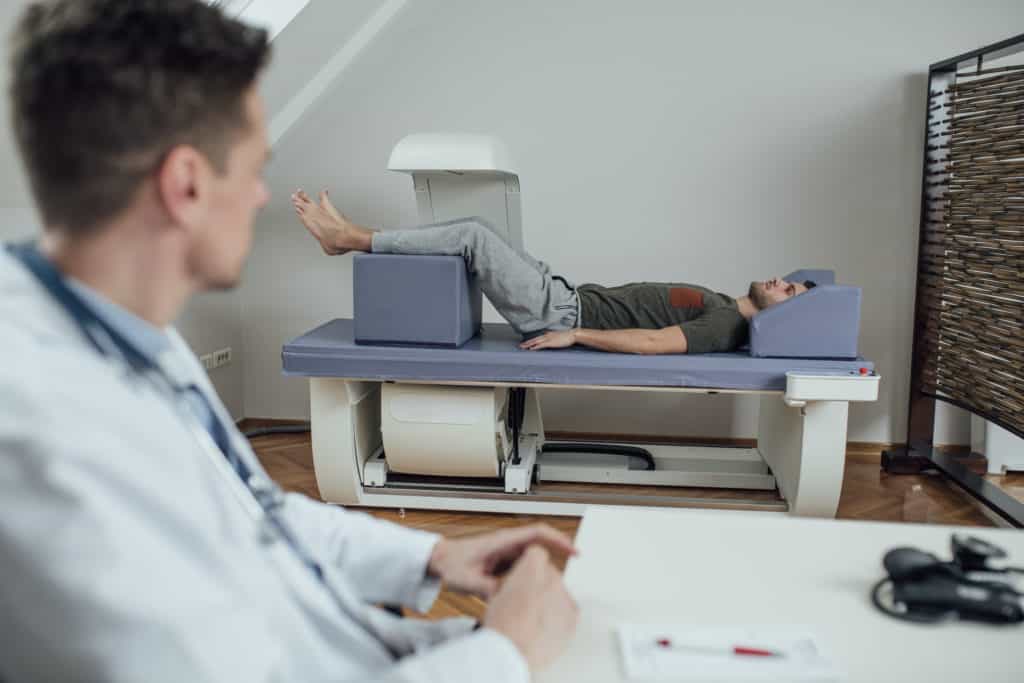A dexa scan assesses bone density; the scan works by measuring the amount of minerals (mostly calcium and phosphorous) contained in a certain volume of bone to determine the ‘density’ of the bone. The dexa scan is carried out by transmitting low dose x-rays usually in the hips and lower spine when checking for the most common bone density disorder, osteoporosis.
What is osteoporosis?
Osteoporosis is a bone disease that occurs when the body loses too much bone, produces too little bone, or both. As a result, bones become weak and may break easily from a fall or, in serious cases, from minor bumps.
Osteoporosis symptoms
- Back pain, caused by a fractured or collapsed vertebra.
- Loss of height over time
- A stooped posture
- A bone that breaks much more easily than expected
Many times, osteoporosis is not discovered until weakened bones cause painful fractures usually in the back or hips. Unfortunately, once you have a broken bone due to osteoporosis, you are at high risk of breaking another. Fortunately, there are steps you can take to help prevent osteoporosis like maintaining a healthy intake of calcium and vitamin D rich foods and regularly undergoing a dexa or BMD scan to ensure the health of your bones.
Similar to Osteoporosis, Osteopenia is another condition which causes thinning of bone mass. While this decrease in bone mass is not usually considered severe, unfortunately, it usually further develops into osteoporosis.
Menopause and osteoporosis
There is a direct relationship between the lack of oestrogen during menopause and the development of osteoporosis. Early menopause (before age 45) and any prolonged periods in which hormone levels are low and menstrual periods are absent or infrequent, can cause loss of bone mass.
Risk factors
Hormone-related disorders that can trigger osteoporosis include:
- Overactive thyroid gland
- Disorders of the adrenal glands, such as Cushing’s syndrome
- Reduced amounts of sex hormones (oestrogen and testosterone)
- Disorders of the pituitary gland
- Overactivity of the parathyroid glands
Other factors thought to increase the risk of osteoporosis include:
- Family history of osteoporosis
- Parental history of hip fracture
- A body mass index (BMI) of 19 or less
- Long-term use of high-dose steroid tablets
- Having an eating disorder, such as anorexia or bulimia
- Heavy drinking and smoking
- Rheumatoid arthritis
- Malabsorption problems, as in coeliac disease and Crohn’s disease
- Some medicines used to treat breast cancer and prostate cancer that affect hormone levels.
- Long periods of inactivity, such as long-term bed rest
Bone density is measured by a ‘T-score’; a T-score compares bone mass to that of a normal score. The “T” in T-score represents the number of standard deviations, or units of measurement, your score is above or below the average bone density for a healthy adult of your same sex.
A normal bone density T-score is usually around +1.0 to -1.0. Low bone density would be somewhere within the range of -1.0 to -2.5 and an extremely low bone density score at high risk of osteoporosis would be around -2.5 or higher.
Treatment
Several different medicines are used to treat osteoporosis and sometimes osteopenia such as bisphosphonates. Bisphosphonates slow the rate that bone is broken down in your body. This maintains bone density and reduces your risk of a broken bone.
There are a number of different bisphosphonates, including:
- Alendronic acid
- Ibandronic acid
- Risedronic acid
- Zoledronic acid
Bisphosphonates are given as a tablet or injection and usually take 6 to 12 months to work, but may need to be taken for 5 years or longer.
Selective oestrogen receptor modulators (SERMs)
- SERMs are medicines that have a similar effect on bone as the hormone oestrogen. They help to maintain bone density and reduce the risk of fracture, particularly of the spine.
Parathyroid hormone
- Parathyroid hormone is produced naturally in the body, it regulates the amount of calcium in bones.
- Parathyroid hormone treatments (such as teriparatide) are used to stimulate cells that create new bone and are given by injection. While other medicines can only slow down the rate of bone thinning, parathyroid hormone can increase bone density.
Calcium and vitamin D supplements
- Calcium is the main mineral found in bone, and having enough calcium as part of a healthy, balanced diet is important for maintaining healthy bones.
HRT (hormone replacement therapy)
- HRT is sometimes taken by women who are going through the menopause, as it can help control symptoms.
- HRT has also been shown to keep bones strong and reduce the risk of breaking a bone during treatment.
Testosterone treatment
- In men, testosterone treatment can be useful when osteoporosis is caused by low levels of male sex hormones.
When should I get a dexa scan?
Unfortunately, osteoporosis can cause premature death, so it is important, like all disease, that it is detected at the earliest possible stage. Bone density starts to deteriorate approximately by your late 30’s. depending on your age, a dexa scan is essential every 2 to 15 years.
Please contact us for more information or to book in.
Click here to view or download our brochure.
Sources
NHS.com- https://www.nhs.uk/conditions/osteoporosis/
Healthline.com- https://www.healthline.com/health/osteoporosis
Mayoclinic.com- https://www.mayoclinic.org/diseases-conditions/osteoporosis/in-depth/osteoporosis-treatment/art-20046869
Ageuk.com- https://www.ageuk.org.uk/information-advice/health-wellbeing/conditions-illnesses/osteoporosis/





